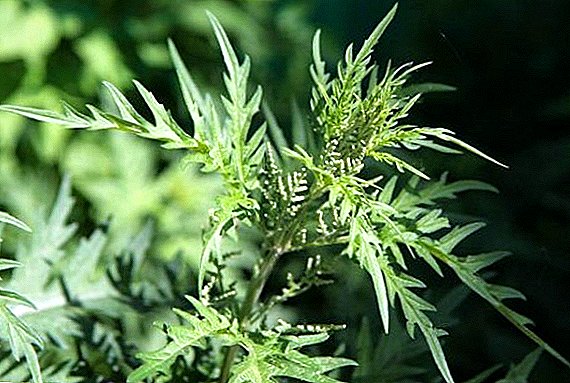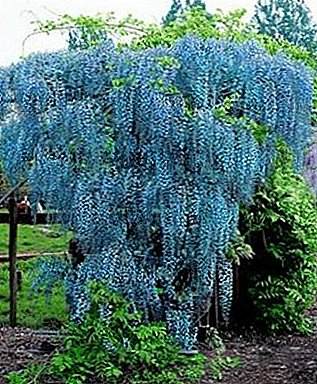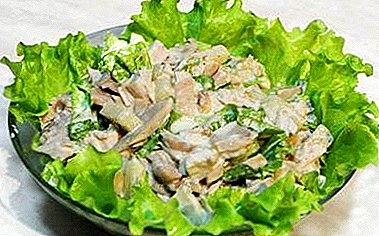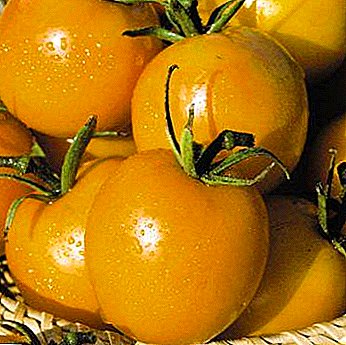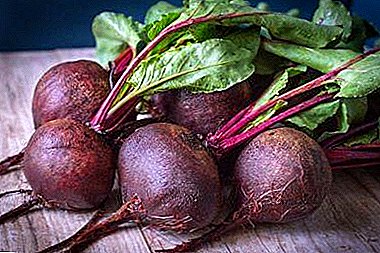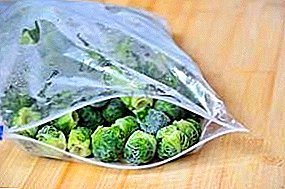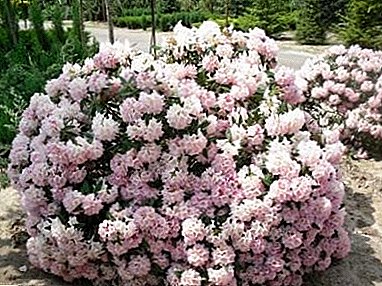 Varietal novelties always attract attention. Sweet, large berries, bushes, bearing fruit during the whole period are not all the advantages of new varieties. One of these new products is raspberry "Caramel".
Varietal novelties always attract attention. Sweet, large berries, bushes, bearing fruit during the whole period are not all the advantages of new varieties. One of these new products is raspberry "Caramel".
It appeared not so long ago, in 2013, and the owners of this variety were satisfied with the first harvest.
Description of raspberry variety "Caramel"
Raspberry "Caramel" refers to medium-grown crops, the height of which does not exceed 1.5 meters. The bush of this variety is dense, steady, upright.
The stalks of the bush are covered with infrequent spikes, which makes it easier to harvest and care for raspberries. The leaves of "Caramel" - typical form of raspberry.
It is possible to grow this variety in small areas and on an industrial scale.
 The notion of raspberry "Caramel" would not be complete if the description of the variety does not mention the fruits. The berries of this raspberry are rather large - 12-15 g, sweet, juicy, and in taste and aroma they resemble forest raspberries. The stem is separated easily, which is very convenient at harvest.
The notion of raspberry "Caramel" would not be complete if the description of the variety does not mention the fruits. The berries of this raspberry are rather large - 12-15 g, sweet, juicy, and in taste and aroma they resemble forest raspberries. The stem is separated easily, which is very convenient at harvest.
Fruits "Caramel" - dense, perfectly preserve the appearance during transportation. The bush begins to bear fruit in the first year after planting. The Caramelka raspberry is highly appreciated, and its yield is about 5 kg from a bush.
The advantages and disadvantages of the variety
The benefits of raspberry "Caramel" include:
- high and fast yields (fruits can be harvested in the first year);
- the possibility of harvesting with the help of mechanical devices;
- delicious taste;
- resistance to temperature extremes;
- appetizing presentation;
- the possibility of eating fruits for 30 days.
Among the shortcomings worth noting the formation of a small number of new shoots. This is due to the fact that this variety was bred in order to obtain a good harvest. In addition, the plant does not tolerate drought, and therefore needs regular watering. 
How to choose healthy seedlings when buying
In order to get the desired yield, even before planting, you need to choose the right seedlings. First of all, they must be healthy in order not to die during the growing season. For remontant varieties, this is especially important because fruiting comes early, and the bushes grow quickly.
It is best to buy seedlings in specialized stores. To choose a future bush, you should follow certain rules.
First of all, remember that in spring seedlings leaves are not always present. Therefore, if the selected instance has them, this may indicate that the sapling has suffered wintering and, most likely, the basic rules for wintering have not been observed.
Such sprouts look beautiful, but their acquisition may be a mistake. These caramel raspberry seedlings took a lot of effort to grow foliage, and after planting they may not bloom in the first year, despite all the efforts and observance of the rules of care. In addition, such specimens will take root worse than non-attractive branches.
 You should pay attention to the fact that the seedlings were not dried, poorly terminating leaves. This may indicate that seedlings are harvested incorrectly, or they are damaged by insects. These branches simply do not take root in the area.
You should pay attention to the fact that the seedlings were not dried, poorly terminating leaves. This may indicate that seedlings are harvested incorrectly, or they are damaged by insects. These branches simply do not take root in the area.
Last year's shoots should not have signs of mold or diseases (dark or light spots can tell about their presence). The cut of the core of the seedling should be the same tone as the subcortical layer of raspberry.
Before you make the final choice, you need to carefully examine the roots of the young raspberries - they must be alive and easy to bend. It would be nice if the roots are already pre-placed in a special substrate or packed in a film with a nutrient mixture.
Important! Raspberry seedlings should be smooth - atypical bends and knots on the stem indicate the possible presence of root cancer.
When and where is better to plant raspberry "Caramel"
Raspberry likes protected, sunny (at least half a day) areas with well-drained soil. An ideal place for planting - the south side without buildings and high plantings.
Important! Even a slight lack of sunlight and heat can lead to a loss of the crop.
 The raspberry "Caramelka", in general, the requirements for the soil is not too strict: it can grow well and bear fruit on any land, but it feels best in a mixture of humus, superphosphate and potash fertilizers. The only condition - the acidity should be weak or neutral.
The raspberry "Caramelka", in general, the requirements for the soil is not too strict: it can grow well and bear fruit on any land, but it feels best in a mixture of humus, superphosphate and potash fertilizers. The only condition - the acidity should be weak or neutral.Did you know? Repair raspberry varieties are more resistant to pests and various diseases, so it is much easier to care for it.In the suburban areas, when planting observe the distance between the rows of raspberries in 1.5 meters, and between seedlings - in 50-70 cm.
Young raspberries are planted in the open ground in spring or autumn, preferably in the evening or in cloudy weather. When planting plants in the spring, it is better to choose the area where the snow comes off first, so it starts to melt faster on small heights well fertilized with manure or organic matter.
In spring, seedlings are planted in early March, when the land is already thawed. In autumn, in September-October, they consider this time preferable, since raspberries will better strengthen the root system for the new season.
 Well, if the predecessors of raspberries were potatoes, peppers, tomatoes or eggplants. In no case can not be planted "Karamelku" in the same area in which raspberries were previously growing - the soil is tired there, which will adversely affect the yield.
Well, if the predecessors of raspberries were potatoes, peppers, tomatoes or eggplants. In no case can not be planted "Karamelku" in the same area in which raspberries were previously growing - the soil is tired there, which will adversely affect the yield.
Since raspberry roots secrete special substances, it can be planted only in 5-7 years.
How to plant raspberry seedlings
Two weeks before disembarking, the site should be re-digged and leveled. Then prepare pits with a depth of 40 cm (at 50 cm in diameter). No more than 3-5 plants should be planted per 1 m², because only this way provides additional ventilation. In the fall, one-year-old healthy seedlings with a developed root system are planted, and young offsprings are used to plant the Caramelka raspberry in spring.
In the prepared pits add 2 tbsp. spoons of superphosphate, the seedlings themselves are shortened to 25-30 cm, immersed in the wells and sprinkled with earth (it is important that there are no voids left in the rhizome).
Under the load of fruits, raspberry bushes need a support, therefore "Karamelka" is recommended to be planted in a trellis manner.
Proper care is the key to a good harvest.
In the care raspberry "Caramel" is not picky: rather regularly water it, loosen it and keep the weeds from growing. 
Treatment and protection from pests and diseases
Due to the fact that raspberries love loose earth and humus, consisting of rotting leaves and twigs, it can be affected by such pests as:
- pincers;
- collembola;
- raspberry beetle;
- aphid;
- kidney mole.
To prevent infection using folk, biological means, so as not to destroy the beneficial insects in the garden. If pests do occur, use insecticides (for example, Actellic, colloidal sulfur, etc.).
Did you know? Raspberry is widely used in traditional medicine. Its berries contain tannins, pectins, fiber, iron, copper, folic acid, vitamins B12, B1, PP, C.
Regular watering
 To collect a good harvest of raspberries, you need to water it regularly. It is especially important to monitor the moisture of those who grow "Caramelka" in the southern regions.
To collect a good harvest of raspberries, you need to water it regularly. It is especially important to monitor the moisture of those who grow "Caramelka" in the southern regions.
The frequency and volume of irrigation depends on the abundance of precipitation, air temperature and the type of soil.
Most often, during the growing season, “Caramelka” needs to be watered once every 2-3 weeks with 5–10 l of water under each bush, and if the summer is droughty, then this amount is increased.
Important! Excessive watering can lead to a fall in the crop and rotting of the roots, so it is better not to pour raspberries than pour.For watering plants, you can use several methods:
- sprinkling;
- hose or irrigation systems (a lot of water is consumed, since the soil is also moistened between the rows);
- irrigation watering.
Watering is stopped in August or early September.
Mulching and loosening the soil
 Loosening the soil has a beneficial effect on the growth and fruiting of raspberries. It is necessary to loosen every 1.5-2 weeks and only the surface layer, that is, no deeper than 6-7 cm. At the same time, it is recommended to combine the loosening process with soil mulching (using peat and humus), as well as fertilizing.
Loosening the soil has a beneficial effect on the growth and fruiting of raspberries. It is necessary to loosen every 1.5-2 weeks and only the surface layer, that is, no deeper than 6-7 cm. At the same time, it is recommended to combine the loosening process with soil mulching (using peat and humus), as well as fertilizing.
Fertilization
Top dressing raspberries - a prerequisite for a good harvest.
Fertilize "Caramel" three times throughout the season:
- In March, organic and mineral fertilizers are applied. Natural fertilizer (mullein, bird droppings) is diluted with water and applied 4-5 liters of the mixture per 1 m². It should be borne in mind that 1 liter of mullein is diluted in 10 l of water, and 1 l of litter - in 20. A mixture of ammonium nitrate (15 g) and urea (10 g) is used as a mineral supplement. This composition is sufficient for 1 m². Before applying mineral fertilizers, a groove is dug around each bush, where fertilizing is placed. After fertilization, the bushes are watered, and mulching is performed with peat or straw (layer - 7 cm).
- During flowering fertilizing is made, consisting of 2 tbsp. tablespoons of potassium sulfate, 3 tbsp. spoons of double superphosphate and 10 liters of water. This portion is sufficient for 1 m².
- After fruiting - in the second half of September. To do this, use 1 tbsp. spoon of potassium sulfate, 2 tbsp. spoons of superphosphate, 10 liters of water. This volume is enough for 1 m².
Raspberry Bushes
 First of all, the garter helps increase yields.
First of all, the garter helps increase yields.
Although the raspberry "Caramelka" and strong stems, but under the weight of the fruit they can bend to the ground. With the help of tying, the bush is provided with uniform illumination, good ventilation and prevention of infection with fungal infections.
For the manufacture of a trellis near the bushes (at a distance of 3-4 meters from it), installed two-meter pillars (to a depth of 45-50 cm). Between the pillars, at a height of 75, 100 and 160 cm, the wire is stretched. After that, you can tie up bushes to the support.
Literate pruning
After harvesting the raspberry bushes need to be cut. When the leaves completely fall off, the stems are cut flush with the ground so that the plant does not freeze through in winter and give a good harvest in the next season.
If the shoots are not cut in the fall, they need to be tied up and bend to the ground, and for additional protection to cover with agrofiber.
In the spring of new shoots should be thinned so that the bushes have enough space for growth. Perform this procedure in April and pruned branches to the first real bud.
Important! If you do not carry out pruning in the fall, the shoots help the snow to linger on the site, and the plant will transfer the winter easier.
 In June, should also be pruned bushes in order to remove weak stems and excess processes.
In June, should also be pruned bushes in order to remove weak stems and excess processes.The shoots are cut with sharp shears to the base of the roots.
Winter raspberry
Before hibernating raspberries, the surrounding area must be cleaned from leaves, which should be immediately burned.
Terms of ripening and harvesting raspberries
The fruits of "Caramel" reach maturity in late July-mid-August. Ripening is uneven, so first they pick only red berries, leaving others for the next day.
Raspberry is better to collect in the afternoon. In order not to miss the ripe berries, you need to pay attention to the lower stems. Remove the fruit from the bush very carefully, without pressing them with your thumb and forefinger. If the raspberry is not separated immediately, you need to leave it for ripening.
Gathering berries in any container, but without processing to transfer them to another container is undesirable, as this may cause damage to the fruit.
Raspberry "Caramel" enjoys well-deserved respect from summer residents, largely due to its yield, viability and resistance to pests. Knowing the details of caring for this shrub, you can enjoy delicious fruits throughout the season.


